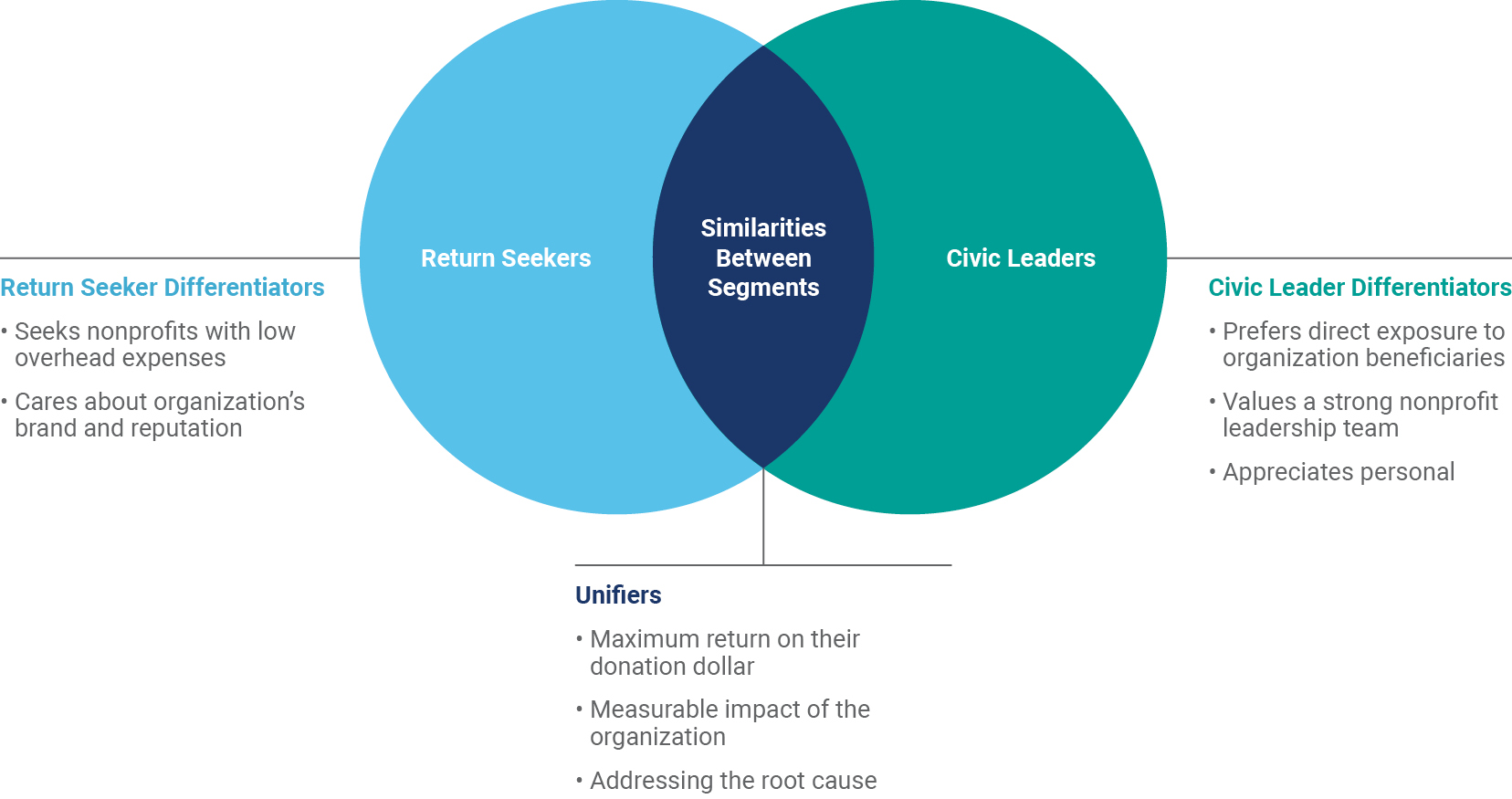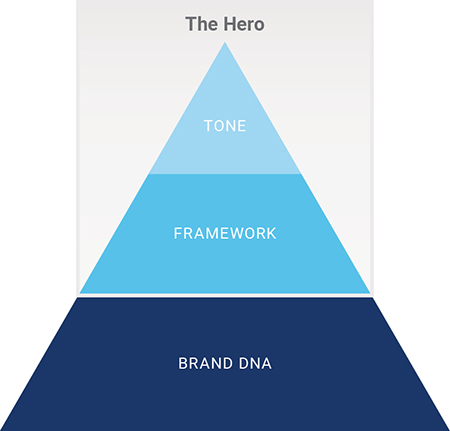Brand Style Guide
Editorial Style Guide
This style guide helps writers convey consistent content tone, style, and voice for all of A Better Chicago’s marketing materials, business documents, and social channels.
CONTENTS
Brand DNA: Our Values
Our values represent our foundation. These are what we know to be at A Better Chicago’s core, and help to define all strategic decisions, messaging components and visual elements.
Innovative
A Better Chicago’s investment approach is helping to transform philanthropy. A Better Chicago is solving problems in new ways.
Inspirational
A Better Chicago proactively makes the change we want to see and spreads hope across Chicago.
Transparent
A Better Chicago is accountable, sharing performance results from both A Better Chicago and its grantees.
Impactful
A Better Chicago delivers results that others are not able to.
Understanding our Audience
The motivations and demographics of our target segments help drive messaging.
Return Seekers
- MOTIVATIONS
- Having a maximum return
- Seeing measurable impact
- Addressing the root cause
- Low overhead
- Brand and reputation of an organization
- Learning and broadening their thinking
- Reading content on websites/social media
- DEMOGRAPHICS
- Oldest segment of all
- Highest percentage of retirees
- Second wealthiest segment, behind Civic Leaders
- Second highest percentage of suburb-dwellers
- Least likely to have children under 18 at home (tied with Civic Leaders)
Civic Leaders
- MOTIVATIONS
- Having a maximum return
- Seeing measurable impact
- Addressing the root cause
- Getting direct exposure to beneficiaries
- Donating to an organization with strong leadership
- Developing personal ties to an organization
- Building their professional network
- Volunteering skills/expertise
- DEMOGRAPHICS
- Highest income of all segments
- Most highly educated and fully-employed of all segments
- Highest percentage of city-dwellers
- Least likely to have children under 18 at home (tied with Return Seekers)
Differences and similarities
Each target segment has both unique preferences and common interests that need to be considered during message development.

Tone of Voice
Tone of voice refers to all written copy, including website, marketing materials, social messaging, donor communications, emails, etc.
- A Better Chicago’s Tone of Voice:
- Uses natural language and avoids jargon
- Is straightforward
- Builds trust
- Influences action
- Expresses who A Better Chicago is, not just what it does
Brand Archetype: Hero
This is for internal use only and should not appear in any marketing material.
A Better Chicago’s brand personality—its archetype—is a hero.
We intuitively “get” archetypes when messaging and visuals are consistent, compelling, and “on-brand.” Nike doesn’t need to tell us they are heroic; TED has become synonymous with wisdom.
- Hero organizations hold themselves to high standards, are achievement-oriented, and dedicated.
- Hero organizations have the passion to make a difference.
- Marketing involves strong, directive language and powerful images that inspire.
GOAL
Help improve the world.
TRAITS
Courageous, bold, honorable, strong, confident, inspirational, positive, upbeat, sincere, and passionate.
ACTIONS
Make a positive mark on the world, help solve major problems, and enable and inspire others.
Messaging that reflects A Better Chicago’s personality—the Hero—helps to “humanize” the brand and deepens connections to the organization
We recognize The Hero in everyone and promote courageous acts that align with A Better Chicago’s mission.
Message Framework
The message framework is the guiding principle to help define messaging that positions A Better Chicago as a market leader, reflects its position as The Hero, and creates impact to engage target donor.
- A Better Chicago IS:
- Confident
- Honest / Candid
- Credible / Smart
- Upbeat / Energetic / Positive
- Passionate
- Empathetic
- Determined
- Personable / Witty
- A Better Chicago IS NOT:
- Arrogant
- Negative
- Boastful
- Sarcastic
- Silly / Juvenile
- Condescending
- Stuffy
Understanding the Message Hierarchy
Hero
Are your words inspiring, engaging, and driving an action?
(See Brand Archetype: Hero)
Tone
The tone we use for all written words. Benchmark against this list (See Tone of Voice) to ensure your words are reflecting your intentions in clear, concise, natural language.
Brand DNA
The foundation for everything A Better Chicago does and defines all strategic decisions, messaging components, and visual elements.
(See Brand DNA: Our Values)
Framework
Guiding principles that define all communications. Make sure your words are using the principles in column 1: What A Better Chicago IS!
(See Message Framework)

Internal Acronyms
NOTE: Acronyms are INTERNAL ONLY and should not be used in copy.
ABC [A Better Chicago]
(more to come)
Word List: A Better Choice
A Better Chicago prefers not to use certain words in their communications. A better choice that conveys the same message is provided for guidance.
(to come)
AP Style Book
Our preferred style is to format copy using the AP Style Book. However, there are certain items—such as list formatting—where A Better Chicago prefers to deviate from the stated guidelines. When appropriate, the guidelines listed here in A Better Chicago’s Brand Style Guide should override the AP Style Book.
Access the online version of the AP Style Book here: www.apstylebook.com
Merriam-Webster Dictionary
For questions of correct spelling, always use the first spelling presented.
Access the online version of the Merriam-Webster dictionary here: www.merriam-webster.com
Grammar, Spelling, Punctuation
Ampersands
Avoid using ampersands (&) in general text, headings, or subheadings—use “and” instead. An ampersand may be used in charts or tables where space is tight, or when it’s part of a company name or book title.
Capitalization
In general, avoid unnecessary capitalization, unless it is the first word in a full sentence, or is a proper noun:
- Anne, Tom, America, A Better Chicago
After a colon
Don’t capitalize the word after a colon.
- I’m about to list several things: one, two, and three.
Book titles
Titles of books (and eBooks) are always in title case (everything but articles, conjunctions, and prepositions capitalized).
- Today I finished reading War and Peace.
Department names
The names of departments are always lowercase.
- The steering committee is meeting on Tuesday.
Job titles
Titles are only capitalized when used directly before a person’s name.
- The president issued a statement.
- President Abraham Lincoln issued a statement.
Use lowercase for terms that are job descriptions rather than formal titles.
- The managing director …
Contractions and Apostrophe (Possessive)
A Better Chicago prefers not to use contractions, but rather spell out both words.
- DO NOT use “she’s”; USE “she is”
- DO NOT use “it’s”; USE “it is”
In general, only use an apostrophe when you need to form the possessive of the word; not the plural. The exception to this is the plural of it, which is “its.”
- The new CEO’s office was painted white.
Space Between Sentences
Use a single space between sentences in all cases.
Single space after an abbreviation or acronym ending the sentence.
- … throughout the U.S. These organizations will …
Comma
Use commas to separate elements in a series, but do not put a comma (also known as the “oxford comma”) before the conjunction in most simple series:
- … the participants worked in government, higher education and nonprofit organizations.
Commas (and periods) always go inside quotation marks.
- Participants characterized the speaker as “intelligent,” “engaging” and “funny.”
Registration and Trademark Symbols
Use ®s and TMs on first reference in copy only. Symbols used in a logo do not count as the first use.
Numbers
Spell out numbers one through nine. Use figures for 10 or above and whenever preceding a unit of measure or referring to ages of people, animals, events or things. Also in all tabular matter, and in statistical and sequential forms.
Ex. The box contained 20 parts.
Ex. The box contained nine parts.
Write out numbers at the start of a sentence.
Ex. Twenty people attended the meeting.
Also see: Hyphen
Dates
When using only a month and a year, do not separate the year with commas. When a phrase refers to a month, day and year, set off the year with commas. (Note: A Better Chicago does not use abbreviated months in copy, such as Jan., Oct., etc.)
- The previous event was held in January 2017.
- January 1 is the first day of the year.
- The event in April 2018 will be memorable.
- The event on April 7, 2018, will be memorable.
- It was Friday, October 20, when she last attended class.
Do not use th, nd, rd or st when referring to a specific date.
- CORRECT: Dec. 4, Jan. 2, April 3, March 1
- INCORRECT: Dec. 4th, Jan. 2nd, April 3rd, March 1st
Percent and Percentages
Use figures for percent and percentage, unless it appears at the start of a sentence.
- The survey results showed that 70 percent of all attendees …
- Seventy percent of attendees …
Use decimals, not fractions, for percent and percentages.
- 2.5 percent
- 4 percentage points
For a range, use “percent” only one time:
- 12 to 15 percent
- … between 12 and 15 percent.
For amounts less than 1 percent, precede the decimal with a zero.
-
The cost of living rose 0.6 percent.
Phone numbers
(123) 456-7890
Time
Use a.m. and p.m. (with periods)
- CORRECT: 9 a.m., 10 p.m.
- INCORRECT: 9 am, 10 pm
Use a hyphen to indicate time span.
- The meeting will be from 9-10 a.m.
Dashes
Use em dashes with no spaces for setting off text or emphasizing a point in a sentence.
- CORRECT: We are failing to prepare our students—and our region—to succeed in the 21st century.
- INCORRECT: We are failing to prepare our students - and our region - to succeed in the 21st century.
Ellipsis
An ellipsis indicates an omission of words. In general, treat an ellipsis as a three-letter word, constructed with three periods and two spaces.
- CORRECT: …
- INCORRECT: . . .
Use a space immediately preceding and after an ellipse, just as you would for any other word.
Hyphen
When a compound modifier-two or more words that express a single concept-precedes a noun, use hyphens to link all the words in the compound except the adverb very and all adverbs that end in -ly.
- A full-time job.
- A well-known man.
- A know-it-all attitude.
- A very good time.
- An easily remembered rule.
When large numbers must be spelled out, use a hyphen to connect a word ending in -y to another word
- Twenty-one
- Fifty-five
Lists
AP uses dashes instead of bullets to introduce individual sections of a list; however, A Better Chicago prefers to use a bullet. Capitalize the first word following the bullet. Use periods at the end of each section, whether it is a full sentence or a phrase. Similarly, do not use semicolons or "and" after list items.
Example:
Services include:
- First service.
- Second service.
- Third service.
Parenthesis
In general, avoid using parenthesis. Instead, try to write the sentence another way. If a sentence must contain incidental material, then commas or two dashes are frequently more effective.